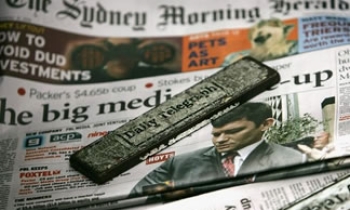Counts of plagiarism and fabrication of news in the United States were higher in 2006 than in the previous year, according to Regret The Error.
Regret The Error, which reports on corrections, retractions, clarifications and trends regarding accuracy and honesty in the US media, says in its annual roundup of 2006, “There's more scrutiny than ever before and Google has made it easier to catch a thief, but the parade of plagiarists and fabricators seems perpetual. Hopefully, this roundup serves as a deterrent.”
The pick of the incidents were:
- In late December 2005 (after the blog’s plagiarism roundup was published), the Toronto Star plagiarised from a decade-old brief written about a Reuters story published in 1995. The brief was published by This Is True. The paper eventually ran a correction but did not acknowledge the theft.
- In January, The Press Enterprise, a newspaper in Bloomsburg, discovered that Kate York, a reporter, fabricated interviews in 24 stories.
- In January, Wikipedia helped expose plagiarism by Honolulu Star-Bulletin reporter Tim Ryan. The paper later investigated and fired him for plagiarising in at least six articles.
- In January, The Cavalier Daily, a student paper at the University of Virginia, discovered that significant parts of a tech column by Michael Desmond had been partly plagiarised from PC World.
- In January, a regional bureau chief and freelance columnist at the Chronicle Herald newspaper in Halifax, Nova Scotia was suspended for six months without pay after the paper discovered more than 10 stories and columns included plagiarised material.
- In January, the Baltimore City Paper revealed that an investigation of columns by Baltimore Sun columnist Michael Olesker showed he had plagiarised on repeated occasions. The investigation followed a Sun correction that said Olesker had “failed to include attribution” in a December column. Olesker subsequently resigned, but admitted no wrongdoing.
- In January, the LA Times published a lengthy correction that sidestepped using the actual word plagiarism, though that’s what had occurred. A December 18 column by staff writer Cecilia Rasmussen led with a plagiarised sentence and proceeded to lift other material.
- In March, ABCNews.com ran an article that was heavily plagiarised from one that appeared in the Boston Globe. It did not name the guilty party and the resulting correction was only on its Website for one day.
- In March, the Village Voice removed a cover story from its website after discovering that the writer, Nick Sylvester, had fabricated parts of it. He was immediately suspended.
- In March, Ben Domenech, a conservative blogger hired by the Washington Post, resigned after he was accused of plagiarising previous work for a student newspaper and in National Review Online.
- In April, Atlanta Journal-constitution reporter Don Plummer resigned after admitting to plagiarising from the Pittsburgh Post-Gazette.
- In April, The Globe & Mail apologised to The New Republic after a profile of Mahmoud Ahmadinejad published in the newspaper included content from a story published in the magazine. The paper called it a failure of attribution, not plagiarism.
- In April, Carla Bagley, a long time reporter with the News & Record in Greensboro, North Carolina lost her job after plagiarising from the Business Journal.
- In May, the Richmond Times-Dispatch fired reporter Paul Bradley after he fabricated part of a story.
- In May, freelance language columnist Howard Richler was fired by the Montreal Gazette after an investigation revealed he had plagiarised parts of his columns. Richler denied the charge.
- In June, The New York Post suspended reporter Andy Geller after he plagiarised from the New York Times. The Post refused to acknowledge it happened.
- In July, the Philadelphia Daily News published an op-ed from a local man who had been a prodigious letter writer to the paper. Then it discovered he had plagiarised almost the entire article. The man later wrote a letter of apology to readers.
- In July, John Heineman, a writer with the Daily Iowan student newspaper, admitted to plagiarising from a Democratic Policy Committee report.
- In July, The New York Post ran an article accusing author/columnist Ann Coulter of plagiarism. Her syndicate and publisher later refuted the charges after looking into the issue.
- In August, the Salt Lake Tribune fired reporter Shinika Sykes after she plagiarised material from the University of Utah's student newspaper. Sykes denied the charge.
- In August, Wired News removed three stories after an investigation revealed fabrications by freelancer Philip Chien.
- In October, the Harvard Crimson fired a writer after her column failed to credit source material to Slate and she wrote about an event as if she had witnessed it, even though she hadn’t.
- In November, the Local, an English language news site based in Sweden, accused Xinhua, the state-run Chinese news service, of repeatedly plagiarising from its work.
- In November, the Star Tribune acknowledged that an editorial had plagiarised from a comment piece in the New Yorker. After refusing to name the guilty party or investigate his previous work, the Power Line blog, which had leveled the initial accusation, revealed more instances of theft. The paper then named the offender and launched an investigation. In the end, it found no further instances and cleared the writer.
- In November, student paper the Daily Northwestern retracted a story and fired freshman reporter Tania Chen after she plagiarised in her first article for the paper.
- In November, the Toronto Star published a story by an inexperienced freelancer that included fabricated and exaggerated quotes. The story went into the paper without any exchange between an editor and the writer.
- In December, the Daily Utah Chronicle, a student paper, fired arts writer Mark Mitchell for serial plagiarism.
- In December, the Badger Herald, a student newspaper, fired its state editor, Dan Powell, after the paper discovered at least 10 of his stories included plagiarised material.
There were a number of incidents of photo manipulation:
- In March, the New York Times Magazine ran an editor’s note after its cover photo of Mark Warner, a former Virginia governor, “rendered colours incorrectly.” As the magazine noted: “The Times's policy rules out alteration of photographs that depict actual news scenes and, even in a contrived illustration, requires acknowledgment in a credit.”
- In August, the Charlotte Observer fired photographer Patrick Schneider after he altered the colours in an image. It was the second time he had done so.
- In August, Reuters fired photographer Adnan Hajj for altering images taken during the war in Lebanon.
- In September, CBS’ promotional Watch magazine altered an image of Katie Couric, making her look much slimmer.
- In November, Marie Claire magazine came under fire for altering an image of Elizabeth Vargas to make it appear as if she was breastfeeding while sitting behind an anchor desk.









